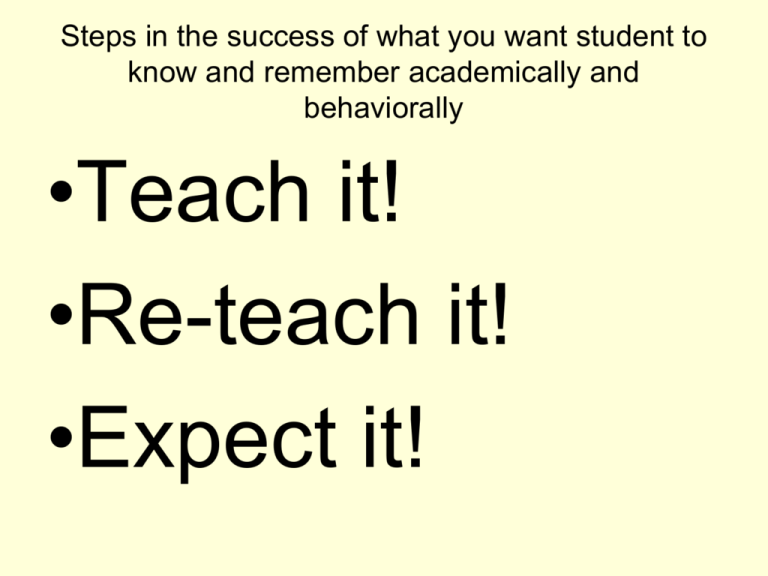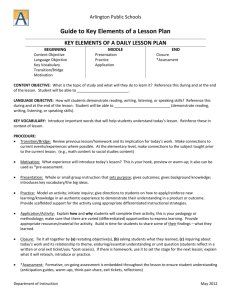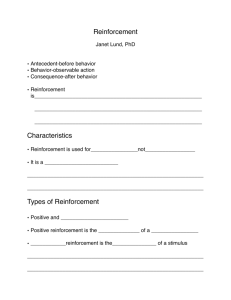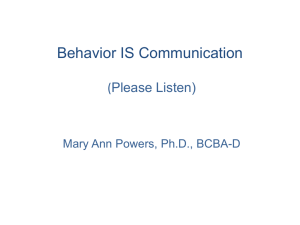APL Instructional Strategies Refresher 101
advertisement

Steps in the success of what you want student to know and remember academically and behaviorally •Teach it! •Re-teach it! •Expect it! Teaching Expectations Randy Sprick Research Teaching Expectations vs Instruction Percentage of Classtime 90 80 80 80 70 60 60 50 40 30 20 Teaching Expectations Instruction 40 20 20 10 0 Week 1-2 Week 3-4 Week 4-5 Implementation Timeline Teach to an Objective • The two components in a objective are: 1. Content 2. Behavior Teachers may also want to include the level of success desired and the conditions under which the behavior will exist. Let the students know the objective, verbally, in written form or both Examples of Objectives • Students will identify in writing (behavior) 10 local landmarks (content) on a map (condition) with 90% accuracy. (level of success) • Students will compute (behavior) on the worksheet (condition) 10 subtraction problems (content) with 90% accuracy (level of success) Building Relationships with Students • Learn about your students, let them learn about you • Portfolio Strategy * • Getting to Know you activity * • Human BINGO * • Assess them on the colors * Students need to know that an adult cares about them in the school. This is the first step in raising student achievement. Withitness • Withitness refers to a teacher’s awareness of what is going on in the classroom Proximity and Body Language • Eye contact, facial expressions, gestures, physical proximity to students, and the way you carry yourself will communicate that you are in calm control of the class and mean to be taken seriously. • Be free to roam • Avoid turning back to class Wait Time – A Three Step Process 1. Teacher asks the question to all students. Name one component of a good paragraph. 2. Teacher pauses and allows students to think about the question and how he/she is going to answer the question. (3 – 5 seconds) 3. Teacher will retrieve the answer from a student. Extended Wait Time - Four Step Process 1. Teacher Asks the question to all students 2. Teacher pauses and allows students to think the question and process his/her answer 3. Teacher allows students to pair up with another student to share each other’s responses – The teacher can tell specific student he/she will be calling on them 4. Teacher will retrieve answers from students Think Time 1. Ask the question 2 Allow Think Time, then 3. Repeat the question 4. Request a response from all or an individual 5. Answers should be something that was reviewed, studied or should be known for all 6. A wrong response would lead back to Remember ….. When we discussed….. 7. Go to another student for a correct answer, then 8. Go back to the student that had the incorrect answer, for the correct response. Provide and Exit - The Pass Option • A strategy designed to facilitate the human needs of students in a structured instructional environment. The pass option may be used by a student when the student does not know the answer, is embarrassed, or was not listening. When the response is given, the teacher goes back to the student who used the pass option and asks them to tell one thing they heard from the previous student. Do not limit the number of pass options a student may use; however, when a student misuses the opportunity to pass, a re-teaching session may need to be scheduled. Checking for Understanding Content: A teacher needs to stop and check for understanding in content approximately every: PreK – 2nd grade --- 3 to 4 minutes 3rd – 6th grade --- 5 to 7 minutes Middle School ---6 to 7 minutes High School ---- 10 minutes 10 to 2 Formula 10 minutes of quality instruction and then, 2 minutes of a summary. Students will remember content much better! Checking for Understanding Questioning techniques by a teacher when monitoring students on whether a direction or part of a lesson is understood. ( Can be used as part of the 10 to 2 Formula) Directions: • Have students repeat the set of directions. • A different student gives each one of the sets. • Don’t have student use hands. • Every time you give a set of direction, check for understanding by asking the students to repeat the directions. • This increases listening skills. Students will start to listen if they know you are going to ask them to repeat them every time. CHAMPS… A Proactive and Positive Approach to Classroom Management Randy Sprick • C Conversation How can students in engage in talking during this activity • H Help How can students ask for help or get questions answered • A Activity What is the expected end product of this activity? • M Movement Can students get out of their seats during this activity? • P Participation What behaviors show that the students are participating fully and responsibly? Uses this for every activity and transition Classroom Management Plan Randy Sprick • • • • • • • • • Guidelines for Success Teaching Expectations Monitoring Procedures Encouragement Procedures Possible Corrective Consequences Procedures for Assigning Class work and Homework Procedures for Managing Independent Work Periods Procedures for Collecting Completed Work Procedures for Keeping Records and Providing Feedback to students • Procedures and policies for Dealing with Late/Missing Work Classroom Conditions Walls Sidewalls are devoted to children’s work such as stories, photos, graphs etc.. Backwall – Use as a teacher reminder, big letter reminders, names of skills you are working on Front Wall – Identify area that you use to teach Classroom Conditions Teacher’s Desk • Should not be in the front of the room … it could be a distraction for students. • It is a personal piece – very tempting to sit if it is in the front. Be on your feet, not on your seat. Teacher Appearance should be neat, clean, and free of body odor. Classroom Conditions Seating Arrangement • U shaped with seating in the outside only – so that everyone has a front row seat. • Helps students focus • Easier to get to students • Always leave breaks in the rows for easy access to students • Troublemakers at the front corners along with procrastinators Classroom Conditions Live Plants Have healthy, well cared for plants. Place around the room to help provide an inviting atmosphere. Equipment Do not have it center stage when not in use. Use timers to help with procrastinator. Homework Guidelines • • • • • • • • • • • • • Kindergarten 1st grade 2nd grade 3rd grade 4th grade 5th grade 6th grade 7th grade 8th grade 9th grade 10th grade 11th grade 12th grade 0 10 min. 20 min. 30 min. 40 min. 50 min. 1 hour 1 hour 10 min. 1 hour 20 min. 1 hour 30 min. 1 hour 40 min. 1 hour 50 min. 2 hours Anticipatory Set Outcomes: Focus and Transfer A mental process where learners are asked to search their past for information that they have about that which is to be taught. -- Ask students to review notes and list three things they learned about the topic previously -- List things you already know about the topic -- Ask students to brainstorm on a topic --Bell Ringer at the beginning of class Table Discussion 1. Think of and write two examples on how you provide a “anticipatory set” in your classroom. 2. Pair up with another person and share them with each other. 3. Share out as a table Example of: Think – Pair --- Share Active Participation Outcomes: Rate, Degree of Learning and Focus The consistent engagement of all the learners with what is being taught. Instructional Closure Outcome: Retention, Rate and Degree A mental process where the learners are asked to summarize their perception of what has been taught. This is best done at the end of the objective and the end of the lesson. -- Ticket out the door -- Learning Log -- Journal a summary --Reflection -- 5 point quiz to see of students mastered the material Instructional Closure Forms of closure • • • • • • • • • Tests Writing samples Practice worksheets Projects Demonstrations Journals Book report Role play Graphic Organizer Criteria and Closure 1. Learner Summary a. Check for understanding b. Repetition c. Self-evaluation d. Find the gaps in the content e. Did I meet my objectives? 2. Relevance to the objectives Success Outcome: Focus A feeling that the learner experiences from genuine achievement. If you want it, teach it! -- Give clear realistic assignments that students can complete successfully -- Adjust assignments for students who need it , low and high -- Use a display or bulletin board to display students work -- Give student a pass option and give students appropriate wait time Reinforcement Outcome: Rate and Degree A procedure using consequences (reinforcers) to strengthen a desired behavior. -- Use positive comments to reinforce efforts -- Use tangible rewards less frequently than privileges and recognition Selecting Appropriate Reinforcers 1. Ask the child. 2. Observe the child’s preferences. 3. Use what worked elsewhere. 4. Give the student choices. 5. Reinforcers lose value over time. Reinforce 4-3 Instructions for Give-One-Get-One 1. Jot down three (3) of your own ideas. 2. Get up and find someone from another table. Share your lists. 3. Give one new idea from your list to your partner. Get one new idea from your partner’s list. 4. Move on to a new partner and repeat Steps 2 and 3. Reinforce 4-6 Instructions for Give-One-Get-One (Cont.) 5. If your list and your partner’s list are identical and you have no new ideas to exchange, you must remain together and brainstorm something that can be added to each of your lists. **Note: Exchange no more than one idea with any given partner. The first person completed with all squares filled in needs to yell I’M Excited to start the new Year!! Reinforcewin 4-6a They will a prize! Give One, Get One Subject: __________________________ Section #4 Reinforce 4-7 Give on Get One Activity The strategy can be used to: • Review information • Gather class information • Adaptable for subject areas and grade levels • Check for understanding • Closure activity 101 Ways To Praise A Child Wow Way to go You’re special Outstanding Excellent Great Good Neat Well done Congratulations Remarkable I knew you could do it I’m proud of you. Super star Nice work Looking good You’re on top of it You’re catching on Now you’ve got it How smart Good job That’s incredible Hot dog Remarkable job You’re beautiful You’re a winner You make me happy Hip, hip hooray You’re important Magnificent Beautiful Fantastic You’re on target You’re on your way How nice You’re spectacular You’re darling Super Super job Beautiful work Good for you Nothing can stop you now Dynamite You’re fantastic Awesome You’re precious Fantastic job You’ve discovered the secret Bingo Great discovery You are responsible You are exciting You are fun You’re a real trooper Marvelous Terrific You’re growing up Outstanding performance You tried hard You figured it out What a good listener You’re a treasure You mean a lot to me You’re a good friend That’s correct A big hug What an imagination You learned it right You’re incredible Now you’re flying Bravo Beautiful I like you I respect you You’re sensational Phenomenal A+ job Hooray for you You’re unique You care Creative job You belong You brighten my day Super work That’s the best You made my day Say I love you Beautiful sharing You mean the world to me You’re important You’ve got a friend You’re a joy You make me laugh You’re A-ok My buddy I trust you You’re perfect You’re wonderful A big kiss Exceptional performance P.S. – Remember, a smile is worth a thousand words! Reinforce 4-8 Discussing Inappropriate Behaviors Do It: Quietly Calmly Privately Every Time You Can! DiscussInapprop 9-1 Goals When Dealing With Difficult Behavior 1. To eliminate or minimize the behavior 2. To maintain student’s self esteem. 3. To maintain the lesson. DiscussInapprop 9-2 Whenever you are dealing with unacceptable behavior always question whether the behavior in question is an isolated event or a recurring symptom of a greater problem. In other words, is it just a headache or is it a brain tumor? DiscussInapprop 9-3 Feeling Tone Outcome: Focus for the learner The feeling the teacher deliberately creates in the environment. The feeling tone may be positive, negative, or neutral. Positive is the most effective, negative is the next most effective and neutral the least effective. -- Greeting students at the door “bonding” -- Having students “buddy check” with a partner before being called upon. / Discussion this with a partner. -- Sending positive notes from home on a regular basis Practice Outcome: Retention Consistent engagement of the learning is repeated, activity designed to correctly produce the desired product. --Ask students to do short bursts rather than long extended practices --Check to see if students understand the concept before they practice on their own -- Ask students to check with a buddy before going too far into the task Knowledge of Results (feedback) Outcome: Focus Feedback to students about how they are doing with content. Should be immediate and specific. -- Correcting a problem immediately after completion -- Returning a test the next class period with opportunities to relearn -- Put specific comments on papers. -- Have students give positive comments on other student’s work Modeling Outcome: Retention Demonstration of a process and/or examination of a product. -- Use a clock to teach time -- Show students sample works -- Demonstrate how to line up --Demonstrate a concept so students know what it looks like or what is expected. Interest Outcome: Focus • Anything that the teacher does that is novel or vivid. -- Use a visual aid --Bringing in an appropriate guest speaker --Dressing up as a character in a book --Change your voice level --Use humor --Use manipulatives --Movies, Videos, CD’s Level of Concern Outcome: Focus Strategies that the teacher uses to manage student’s anxiety. Examples: Time, Proximity, Materials, Activities, Negative Reinforcement, and Extinction Level of Concern Time: On the clock Pass Option Wait Time Wait Time Extended Proximity: Using distance of teacher to manage anxiety of student • standing next to the doorway lowers anxiety (safety) • standing behind student raises anxiety Level of Concern Materials and Activities Materials we ask students to use and activities we ask them to do, may raise or lower anxiety level Examples: • We are going to have a check-up today. (test or quiz) • • • Do two sentences of Daily Oral Language instead of 20 today. Give worksheets one at a time rather than for a whole week. Level of Concern Negative Reinforcement • A temporary absence of a positive reinforcement, but with a cost to the student. • A cost means something unwanted by the student – valued time • Negative behavior leads to absence of positive reinforcement, which leads to negative reinforcement Level of Concern Extinction – 100% planned ignoring of a undesirable behavior will NOT work. Example: Jamie is tapping pencil to irritate me. I decide to ignore it, He gets focus now and escalates, and I will blow up. Do not accept the undesirable behavior and teach the behavior wanted. Meaning Outcome: Retention and Transfer Process of adding significance to the learning being encountered. -- Give examples using class names and activities that students can relate to in a meaningful way -- Have students relate current learning to topics learned previously -- Have students give personal examples to demonstrate the understanding of information Thank You! Marlin Jeffers & Flora Lee Northwest Area Education Agency 1520 Morningside Ave. Sioux City, IA 51106 mjeffers@nwaea.k12.ia.us flee@nwae.k12.ia.us 712-222-6038 712-222-6363








